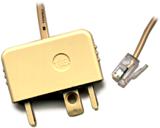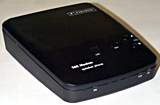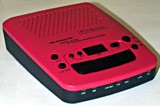
Paradise Wavecom 56K Modem and 56K Modem Pro
Review date: 8 May, 1999.
Last modified
03-Dec-2011.
Paradise Innovations isn't exactly a household name when it comes to modems, but their recent 56K external models are worth considering if you're in the market for a 57,600 bit per second modem with extra voice and fax capabilities.
The plain Wavecom 56K Modem has a feature set not much different from that of various other current 56K modems, but you can also use it as a full duplex speakerphone.
The $270 (Australian dollars) 56K Modem Pro, however, also has a full suite of answering machine controls built in, and can serve as a standalone answering machine. If the modem's turned on, it doesn't matter if the computer's on, off or not even connected - the Pro modem lets you record your outgoing message, listen to messages people have left, or control the answering machine functions remotely from any touch tone phone. The Pro modem can even receive and store faxes; something like 20 messages and/or faxes can be stored at once in the modem's internal memory, depending on size.
The non-Pro modem can do all of these things too, but only if it's connected to a computer running the appropriate software. Pretty much all current 56K modems are capable of this sort of fancy voice-and-fax operation, but not many of them are actually called upon to do it, perhaps because people perceive using their computer system as an answering machine to be too much fuss, or just don't want to leave the PC on. Today's PCs, with their configurable energy-saving settings, actually use very little power when they're sitting peacefully waiting for a call. They certainly don't wear themselves out. But, nonetheless, most cutting-edge modems only seem to get used for plain data communications.
The versions of these modems sold in the USA also support Caller ID, but the Australian version I checked out didn't.
What you get
If you're into brightly coloured hardware, Paradise have you covered with the Pro modem. The one I checked out had a red top panel; you can also get blue, green and yellow ones. There are black and white models for the less adventurous.
As is becoming traditional, the modems come with only slim installation guide on actual paper, with the main manual in Adobe Acrobat format on the software CD (which also contains the Acrobat reader software). The Pro modem's manual is the first CD manual I've seen that comes with printers' cropping and registration marks; they've obviously directly exported a paper-manual file to Acrobat, without removing the peripheral stuff. The plain modem's manual looks normal. Both explain what you need to know clearly enough, in only occasionally funny almost-English.
Unusually, both modems have a nine pin serial connector on the back, against the more usual 25 pin. This is not a problem, though, because they come with an appropriate "double header" cable that lets you connect them to a nine or 25 pin serial port. You also, of course, get an appropriate AC power adaptor, and a telephone cable which, for these Australian versions, has one of our hulking plugs on one end and a standard RJ-11 modular connector on the other. The modems have a pass-through RJ-11 socket, so you can still use your telephone from the same connection.

In case you care, here's what a standard two-pin Australian
phone plug looks like, next to the little RJ-11 connector that's
used in most other places. Australian telephone gear uses RJ-11
sockets, just like everything else; the monster plugs are for
the wall connections.
Huge they may be, but at least bits don't snap off 'em
when you yank 'em through a tangle of other cables, which is
more than I can say about those elegant little RJ-series plugs.
The modems don't have the standard send and receive data lights - there's a power light, and a connection light, and a "SPK" light, and that's it for the plain modem. The Pro model also has ANS, Call Alert, MSG and FAX lights, which are useful for indicating modem modes and messages, and twinkle like a Christmas tree while the modem's interfacing with the computer, but don't do anything during normal data transfer.
The teeny, tinny speakers in most modems are neither loud nor clear enough for voice use. The Wavecom modems use a two inch speaker driver which still isn't going to win any hi-fi awards, but works fine in conjunction with the built-in microphone for answering machine and speakerphone functions. The modems also have the usual 1/8th inch jacks for external microphone and speaker connections, so you can use a headset or similar setup instead of the built-in gear if you like.
Standalone features
The Pro modem's ability to operate independently of the computer tempted me to see how easy it was to set up without a PC connection. It's actually no harder to operate than any basic telephone answering machine, but rather trickier than the better models that have a proper built-in display.
Out of the box, the Pro modem thinks it's January, 1970, and will timestamp all of its messages and faxes accordingly. If you have trouble resetting your clock radio for Daylight Saving Time, setting the correct date and time on the Modem Pro without connecting it to your computer will kill you stone dead. It's actually not that hard - you press Play and Forward at once, and then enter the date and time in DDMMYYHHMM format, referring to an appendix to the manual to tell which button corresponds to which digit. The modem talks to you in a vaguely English female voice, by default, and tells you what keys you've just pressed.
I got the time setting procedure right first time, but then I'm a professional.
The fact that the instructions occasionally get details wrong - "time set" mode is indicated not by the "FAX" LED but by the "ANS" one, for instance - helps not at all. And the buttons themselves appear to be slightly intermittent in their operation - which I think is more due to slow software than poor contacts - and there's a significant delay between pressing a button and having the voice tell you what you did. All of this put together could seriously frustrate the average user.
Actually recording your outgoing message and listening to and deleting incoming messages is simple enough, at least compared with setting the time. If you can work an answering machine, you can use the Wavecom 56K Modem Pro as one too.
Software
The Pro modem comes with BVRP's PhoneTools v2.00, a package in the great tradition of bundled modem software - it's not very elegant, but it's perfectly adequate for the task of managing your modem's functions. There's also a little configuration program that makes it easy, thank goodness, to synchronise the modem to the PC clock, as well as set up other features and change the language used for the modem's voice prompts. The American-accented English voice is awful, the Japanese one seems to be two genders at once, the German one is OK, and I ran out of enthusiasm before I checked out the Italian, Dutch and Chinese ones too.
The plain 56K Modem ships with Trio Datafax Voice v5.3.1, a recent version of this venerable modem management package which, again, does the job perfectly well.
The chips
All of Paradise's modems use Lucent's Venus chipset. Older Lucent chipsets, like the Luna and Mars, achieved a certain popularity in the dirt cheap internal host-based modem market, which led to a perception that Lucent modems weren't very good. That's not true - it's host-based modems as a group that aren't very good, and it doesn't matter what chipset they use.
The Venus chipset includes an onboard controller that makes modems that use it proper, self-contained, works-on-any-computer external units. Venus, by all accounts, offers top-flight 56K performance and is generally highly compatible and reliable.
The fancy extra standalone features of the Paradise modems are made possible by a 1998 "software enhancement" to the Venus chipset.
Testing
As a plain data modem, there's not much to complain about in either of the Wavecom models. They take an unusually long time to get around to dialling out - a delay of a few seconds that I hadn't seen in modems using a different chipset. This is no great problem, but it's a little odd. I also noted that they appeared to have an affection for retraining when connected to my usual, non-56K ISP; every now and then there'd be a brief burst of handshaking-noise from the modem and then communications would resume. No runaway retraining-down-to-awful-speeds or random losses of connection happened, though.
As an answering machine and fax receiver, both modems work as advertised. As mentioned above, the Pro's button interface is a tad clunky, but that's a problem it shares with plenty of other answering machines.
As a speakerphone, both modems worked OK. The speaker is good enough, the proper full duplex operation is pleasing; all they lack is some built-in way to dial a number. As it stands, you either have to dial from the computer (the support software lets you dial numbers manually, as do many other communications packages), or use a regular phone on the same line to initiate the connection and press the speaker button on the modem once you've dialled.
Overall
If you actually have a use for the extra features of the Pro Wavecom modem, they justify the extra price. A standard dual tape answering machine costs $80 or so; a digital one with rather more message storage space than the Wavecoms and a more elegant interface than the Pro costs maybe $140. A regular full-featured voicemodem like the Dynalink I review here costs only $155, versus $270 for the Pro Wavecom model. You can pay rather more than that for a modem - big-name Australian manufacturers like Netcomm and Banksia make modems that cost just as much as the Paradise - but I'm not sure why you'd want to, given the Paradise implementation of the Lucent chipset's good reputation.
If you need a modem and an answering machine, the Wavecom package will save you a little bit of money and cut down the number of gizmoes and cables you have to deal with. The fax storage feature is nice, too. Most modem buyers just want a data device, though, and for that purpose the Wavecom modems are overfeatured.
UPDATE!
As far as I can tell, the makers of these modems have gone out of business. So if you need support, or drivers for some operating system other than the ones supported out of the box, you're probably out of luck.



